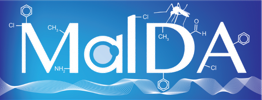Disruption of P. falciparum amino acid transporter elevates intracellular proline and induces resistance to Prolyl-tRNA synthetase inhibitors.
Journal:
Cell chemical biology, Volume: 32, Issue: 10Abstract:
Plasmodium falciparum evades the antimalarial activity of proline-competitive prolyl-tRNA synthetase (PfProRS) inhibitors, such as halofuginone (HFG), by a resistance mechanism termed the adaptive proline response (APR). The APR is characterized by a marked elevation of intracellular proline following drug exposure. Contrary to initial expectations, the APR is not mediated by alterations in canonical proline metabolic pathways involving arginase (P. falciparum arginase [PfARG]) and ornithine aminotransferase (P. falciparum ornithine aminotransferase [PfOAT]). Instead, we identified loss-of-function mutations in the apicomplexan amino acid transporter 2 (P. falciparum apicomplexan amino acid transporter 2 [PfApiAT2]) as the primary genetic driver of this resistance phenotype. Importantly, reversion of these mutations to wild type effectively suppresses the APR, establishing PfApiAT2 as the molecular determinant of this resistance mechanism. The elucidation of the APR significantly advances our understanding of antimalarial drug resistance. By delineating the role of PfApiAT2 in this process, we establish critical insights for the development of strategies to circumvent PfProRS inhibitor resistance for future antimalarial therapies.
